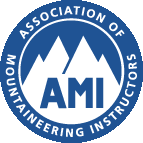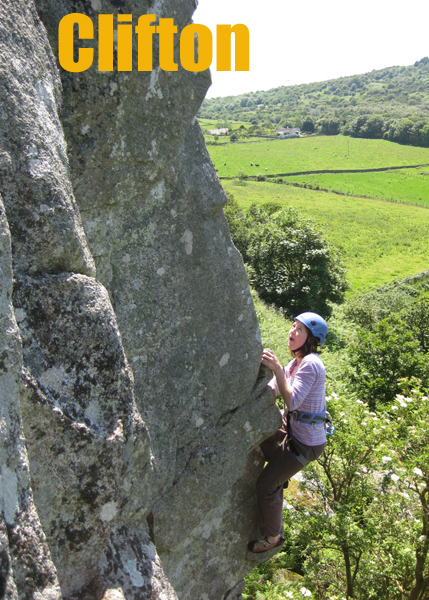
The Arete finish to the excellent HS Sidekick, Hollowstones Wall, Clifton Crag - climber Duncan Dunbar.
Go Climbing Information about the services I can provide as a Mountaineering Instructor.
Clifton Crag Photo Page To keep this web-page a reasonable size most of the photos of climbing here have been moved to this page.
HAZARDS UPDATE The large boulder near the base of the most commonly used descent path at Clifton has moved again recently. Take care when coming down this way, it may move further in future. It's about a 5 to 10 tonner, so it will hurt if it falls on you! I also think the big flake on the traverse of Stiff Upper Lip (where it crosses Labrum) is looking dodgy nowadays. Wish I could remember how it used to look, but again be careful, as both climbs involve hanging on to it with most of your body weight!
......and of course the ticks are back. Check yourself carefully after climbing here, and best not to leave clothing lying around in the grass whilst climbing.
Introduction Clifton is an excellent wee crag in Kirkcudbrightshire, near the town of Dalbeattie and about 20km southwest of Dumfries. It's west facing, gets lots of afternoon and evening sunshine, has a short approach over two fields and has great views over the Solway Firth to St. Bees Head. Certain areas are affected by birds nesting in the spring.
Driving Directions From Dumfries it is best to take the A710 thru New Abbey, Kirkbean and then Caulkerbush. The B793 goes off to the right here, but stay on the A710. About 1 mile further along the A710 is the turn off (right) for Clifton, signposted Southwick Graveyard. You then drive about one kilometre up this very narrow road, stopping about 100m past the cemetery at a Passing Place. From Castle Douglas and Dalbeattie follow the B793 to come down the narrow road to Clifton from the north, or more simply follow the A710 coast road through Colvend and Sandyhills to reach the same turning mentioned above, but the "Southwick Graveyard" sign is hard to spot from this direction.
Access The crag is on a hill east of the road and is obvious. To get to the crag cross a wee granite stile opposite the Passing Place immediately north of Upper Clifton farm. Cross the first field straight towards the crag, passing near a fenced-off barn. A second stile near the highest point of this field leads to the second field. Cross this second field diagonally left to a gate below the far left (north) end of the crag, then follow a short path through bracken up to the foot of Hollowstones Wall. This is definitely the best approach for all routes at Clifton. Even those routes on the buttresses at the far southern end are best approached this way initially. Any attempt at a more direct approach is likely to lead a to a long and difficult battle with boulders and brambles!!! From the base of Hollowstones Wall you can quickly reach the top of the crag via the descent path around the north end of the crag, then stroll easily along the top of the crag to reach all the other buttresses. For routes on the main buttress as far along as Red Slab and DIY you can approach from the gearing up area at the foot of Hollowstones Wall via paths through the trees and brambles at the foot of the crag - these are usually well enough travelled to be free of brambles.
Guidebook Included on this page are a selection of the best routes (in my opinion) at the crag. I climb regularly at Clifton and have pretty much climbed everything here except the two E4's. For a definitive list of all the climbs at Clifton see the SMC published Lowland Outcrops guidebook.
Dangers
Despite initial appearances. and generally very solid rock, there is a fair bit of rockfall
hazard at Clifton. When these rocks
comes off they will come off in big chunks that will seriously damage you and/or
your belayer. Several notable hazards include the following:-
- the lower section of Gibbon in Wonderland
underneath heoverlap
(easily avoided though),
- large possibly loose blocks on Labrum/Stiff Upper
Lip, Nebula/DIY, and Revolver/Bullet
- the bottom of the steep descent
path just left of Hollowstones Wall
- the block at the top of The Groove,
Novice Crack and The Arete (just below the final 1m corner),
which is often tempting to belay or abseil from.... I've seen plenty people use
it!
Dangers Most gear placements at Clifton are very sound, and most routes are very well protected, but the exceptions are suddenly very poorly protected (e.g. the upper slabs of Crackshot and Revolver).... Finally note that there are occasionally bulls in the fields, so take care when crossing them. Remember the most important piece of advice for avoiding death or serious injury if a bull does start to charge at you while you are crossing a field - you don't have to run faster than the bull, you just have to run faster than your friend.
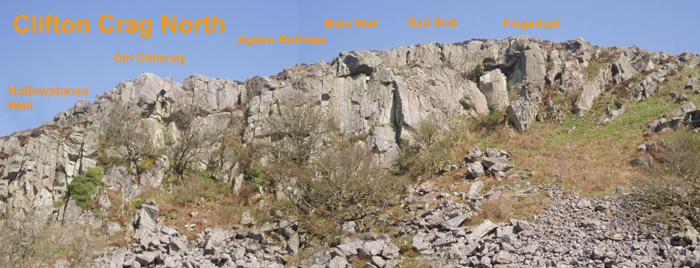
The North End is easily the most popular area of Clifton, and there is enough climbing here to keep most folk going all day. Most routes can be accessed by rocky paths running through the trees below the crag, but the Fingerlust area is probably best reached by going up and around and then back down. The descent path for nearly all routes lies just to the left of the photo - there are two commonly used paths - you can come down more steeply (an easy scramble with a loose block), or less steeply (through the gorse) depending on how far north you go.
More detail of these different areas, including route topos, are further down this page, or reach them from the links below.
Hollowstones Wall and Dirl Chimney
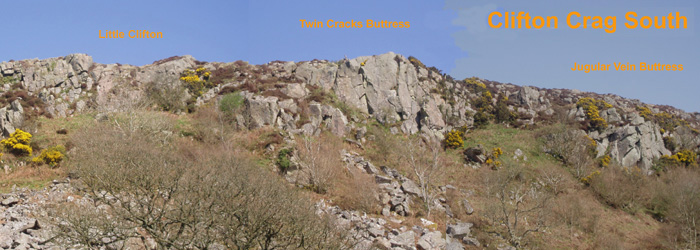
These three buttresses are separated from the right hand (south) end of the first photo by about 50-100m. further right still is the excellent Sunset Slab. All of these are best approached along the top of the crag from the north. Either abseil in to these buttresses, or descend (all three of them) on the right looking down - i.e. the left hand side looking at this photo.
More detail of these different areas, including route topos, are further down this page, or reach them from the links below.
Clifton Crag North
The first area reached is Hollowstones Wall, the most accessible and some of the easiest climbing at the crag. Also featured here is one of the best routes at the crag - the classic and well protected VS, Dirl Chimney. This starts immediately under the bottomless chimney at a crack with a retained but loose block. There is a further tricky move to enter the bombay chimney. Once in the chimney you can rest forever. Getting out of the chimney relies on a large jug, which makes for an easy exit once you find it..... Jeune Ecole, S is another great route taking the short steep crack above the left side of the big square ledge, then moving out on to the juggy arete. The bottom section of Hollowstones Chimney is now overgrown, but the top half is still good and can be accessed from the same big ledge..
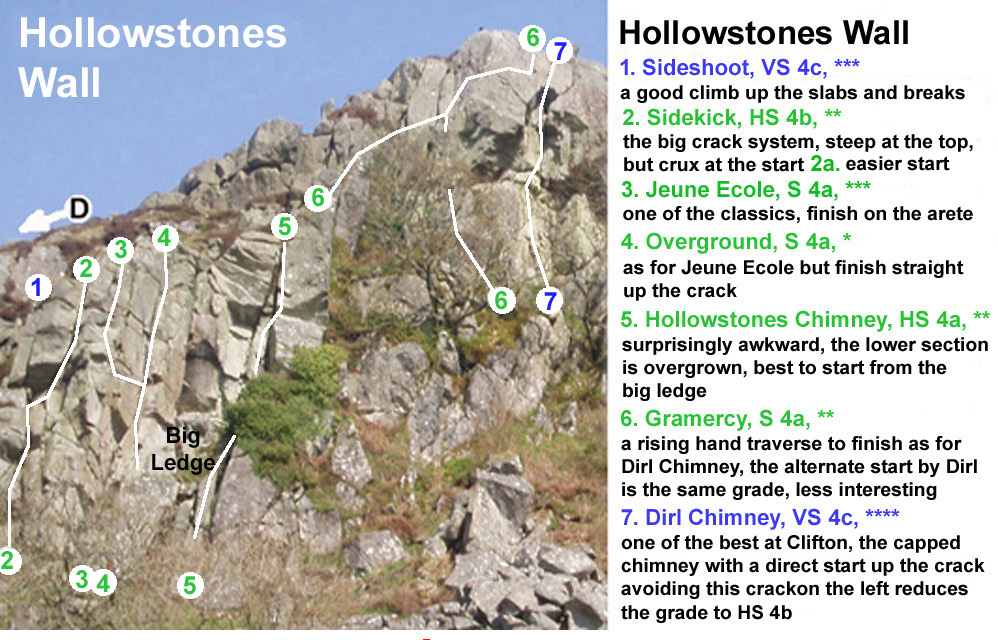
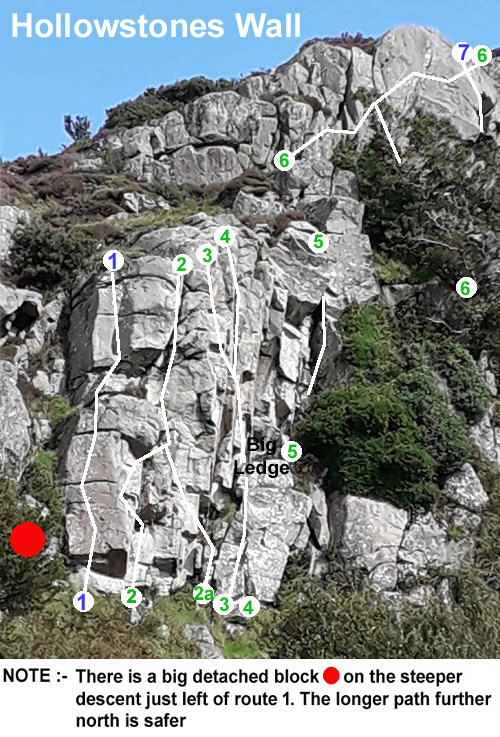
The next main area along is known as Jigsaw Buttress. It is well hidden by trees in summer but contains several good routes including the intriguing Liplet. Also included on the left of this diagram are a couple of good routes just right of Dirl Chimney, these are Gibbon in Wonderland and Tour de Force. Gibbon takes the big obvious fist size crack through the roof, bridge or jam according to taste... HVS if you have wires and hexes, but only VS if you have both size 4 and 5 cams. Tour de Force starts slightly to the right. It climbs the steep wall behind the branch (zig-zagging right then back left is the best technique here), then the right facing overlap and, after a hard move, the final groove. The easiest line is very devious and is hard to see from below. Liplet is one of the classics at Clifton, a bewilderingly difficult severe the first time you try it! But it does get a lot easier with prior knowledge. Long Ears makes a great prelude to this route, giving a total of 20m climbing. It starts with a hard pull into a crack.
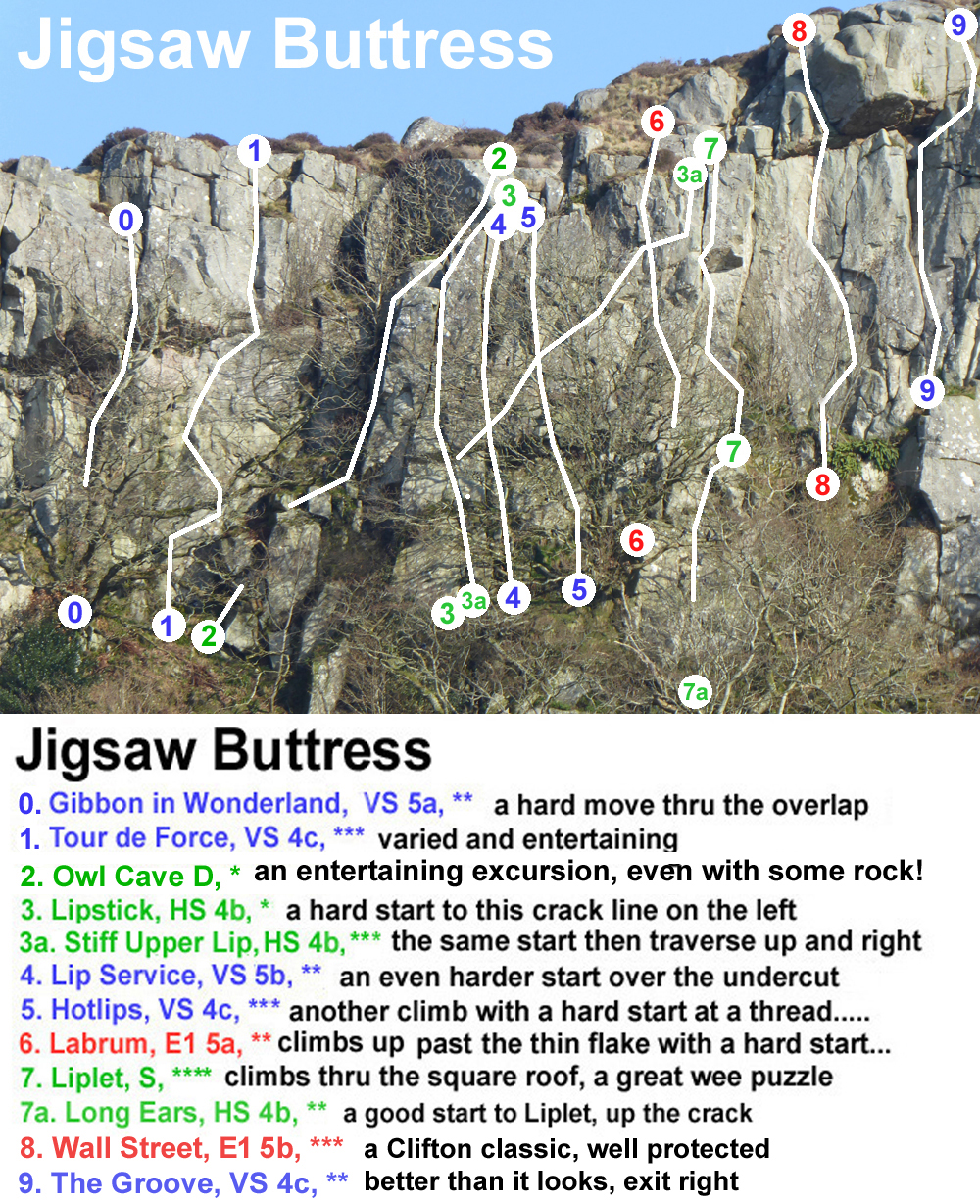
The next area along is the Main Wall. Climbs 1 to 5 start from an exposed ledge that can be gained from either end. Route 9 is now very overgrown with brambles for the first 3 or 4 metres, and will need extensive cleaning before being climbable again. Routes 8, 9a, 10 and 11 are mostly OK once you are on the rock, but it can be hard to get to the base of them thru the brambles.
Watch out for the block at the extreme left hand end of the terrace, 2m below the crag top. It is very loose, moves a few centimetres with a sharp kick, but this is not always immediately obvious.... better not to use it as a belay and definitely don't abseil or lower from it!!
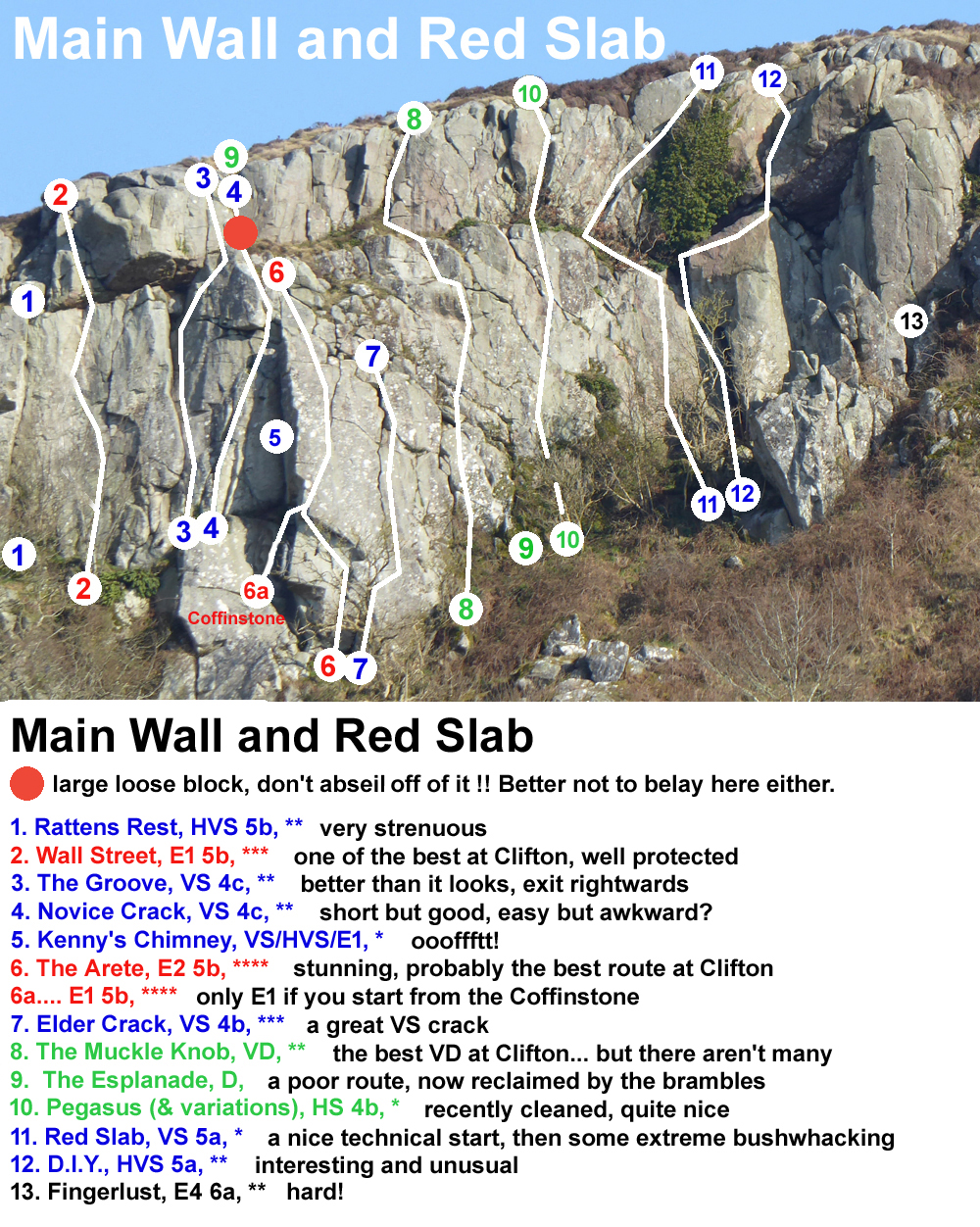
Beyond the Main Wall there is no climbing for 100m or so until you get to the buttresses of Clifton South.
Clifton Crag South
South of the main crags are a number of smaller isolated buttresses. Some of the routes here, such as Twin Cracks and Jugular Vein, should not be missed. Approach along the top of the crag. First to be reached, about 50m before Twin Cracks and marked by a large grassy bay at the top, is the previously overlooked area of Little Clifton. This area is now extremely overgrown, but it had one good route, the 10m slab of nice granite taken by Piece of Cake and various other routes of interest only to those who have climbed everything else...!. Descend this buttress on the right (facing out), i.e. the true north.
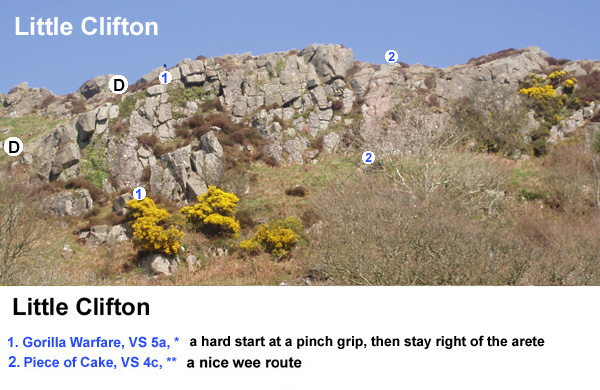
As you walk south the next outcrop you encounter is the Twin Cracks Buttress. There are several very good climbs here, particularly Twin Cracks itself. You can downclimb easily on the right (facing out) but this is now quite overgrown so it may be easier to abseil down the line of Crackshot. Anchors are a good 5 metres back, so you may need an extra rope to set up this abseil.
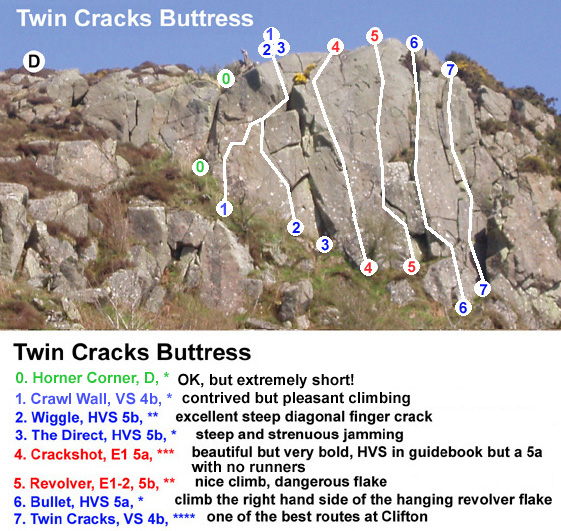
A hundred metres or so further south still there is more excellent rock climbing on Jugular Vein Buttress, most of the routes here are pretty hard. Unbelievably The Slash was given only VS, 4c a few years ago, personally I find it quite a bit harder than several of the guidebook E1's. The best approach to these routes is by abseiling down the line of the Slash, a third rope for rigging this abseil is very useful as the belays are a long way back. The crag top is now quite overgrown with gorse bushes, complicating this set up, and maybe some of the finishes! Descending to the base of the crag on foot is now difficult and seriously overgrown.
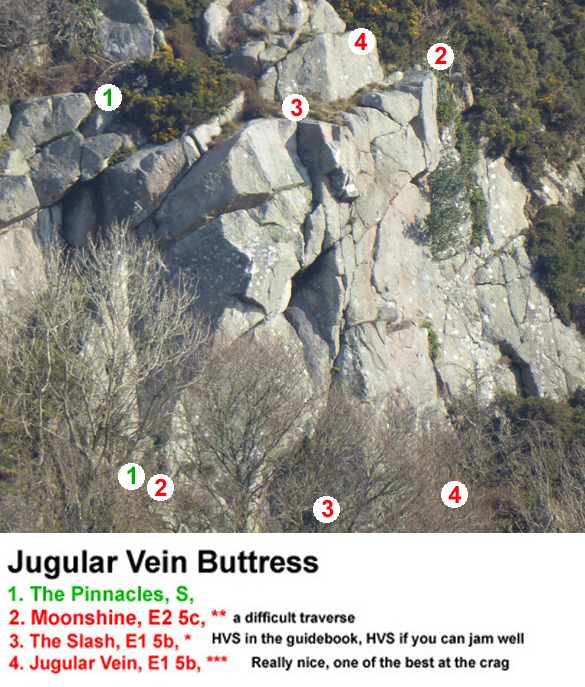
Beyond this buttress there is one further area, Sunset Slab. It has some fairly bold slab climbing quite different in character to other areas of Clifton. As with all the buttresses at Clifton the best approach is along the top of the hill from the north end. You'll need 25m or so of rope to spare to reach the best belay, which is back and slightly seaward from the top of the crag. The belay needs 2 or 3 big pieces, the routes need mostly small to mid-sized cams.
Either abseil in or (easier!) downclimb on the right facing out. Parts of the slab are quite lichenous, but the holds needed to climb these routes are brushed clear by myself every year or two. Sunset, VS 4c, in particular is a really nice technical route, it starts 1m right of the central vertical crack (which is Crack Up), climbs to the horizontal break and then on up and slightly right on small pockets and ledges. Frictional Belief, E2 5b, gives good independent climbing, although if you are the type of climber who likes to place runners you will have to weave around a bit (side runners reduce the grade to E1 5b). Further right are one or two poor quality routes.

Links
Clifton Photos page (on this website)
Clifton Farm Accommodation near Clifton Crag.
Galloway Climbing An excellent set of web pages run by Stephen Reid of Needlesports with some good Galloway climbing information, including many new routes we did together in the last few years. Excellent topo diagrams of some of the newer climbing areas.
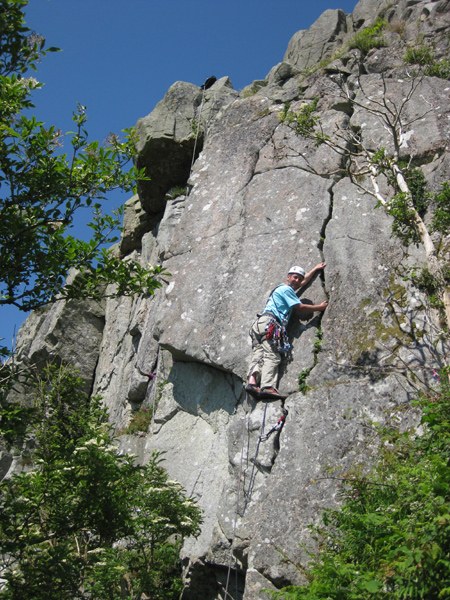
Climbing Elders Crack on a perfect Clifton afternoon.

